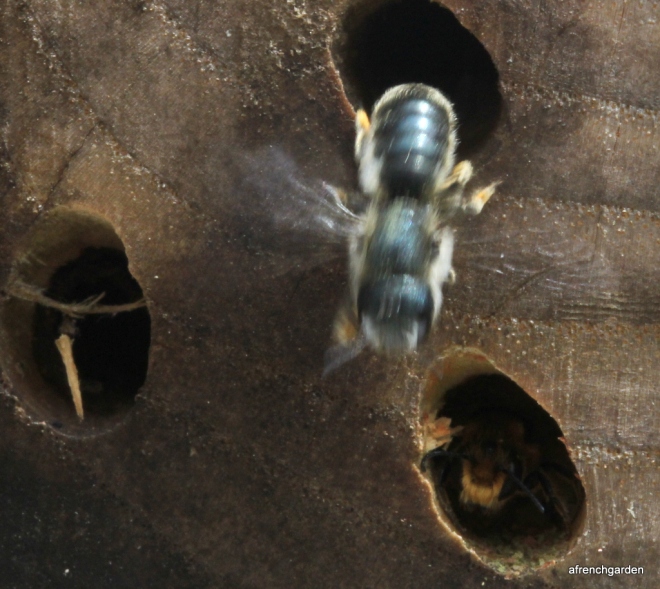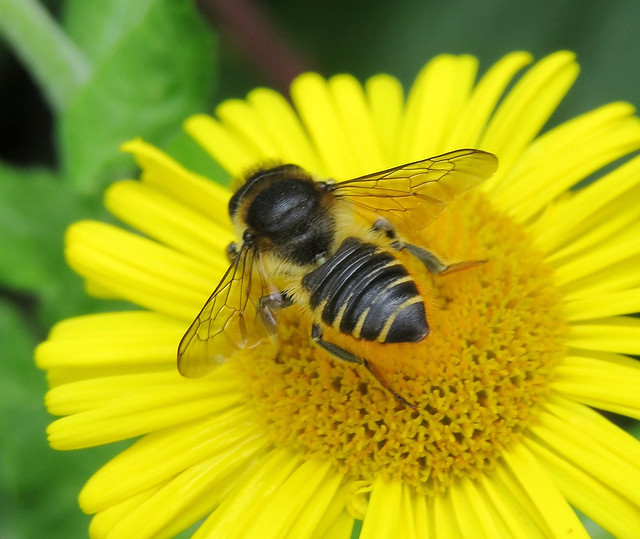On the fourth of September last year I noticed a hole in my bee hotel had been beautifully sealed by carefully arranged sections of rose petals. (See Some Megachile).
On the 24 of May this year I noticed a hole had been chewed in the centre of it.
I could not resist removing the remains of the rose petals to get a better look. A new little bee was making her way into the world. However, it was 19.20 and domestic duties called and the light was fading for photographs.
It was 11.04 the next morning before I was able to get back to my bee and she seemed just to be waking up.
Seven minutes later and she was not making an enormous progress.
Then two minutes later there is movement from the hole above her.
Now which one should I focus on? The other one is larger and not the same species. Very interesting but I do not want to lose my rose petal bee.
After a couple of minutes hesitation the big bee launches itself into the air. Sorry about the blur but it was the best I could do. I have no idea what species it was.
Back to my rose bee that has been emerging gradually for the last 34 minutes. She seemed to have a considerable difficulty pulling herself through the little hole she had chewed in her leaf capsule that had been her home since last September.
Finally after watching and taking photographs of her for 35 minutes she emerges onto the outside of the log.
She paused momentarily before taking off. After this first one, many others emerged from the same hole in the following few days, usually taking less time to exit than this first one. Sometimes it looked as if the bee next in the queue was giving encouragement from behind because as one took off, another little head appeared at the hole.
However, I am not certain what species of leaf cutting bee she is. Megachile centuncularis are well known for their use of rose petals which points me in this direction. It is a common bee and I have seen bees looking like Megachile centuncularis on the bee box last year.
Could this be Mummy emerging from another hole in the log on the 26 August last year?
I base my identification of the bees I saw filling the holes last August on Steven Falk’s wonderful photographs and information
, he says females can be distinguished from some other British species by the bright orange pollen brush that remains orange haired to its tip (black-haired at tip in some others).
Well, even if I cannot be 100 percent sure of my French bees at least I can say I breed beautiful bees!















Perfect, Amelia; I love your bee. I wish I knew where the leaf cutters take my roses!
LikeLike
I hope it helps to know that it is probably a very cute bee that is making holes in your rose petals and rose leaves. Amelia
LikeLike
Reblogged this on a french garden and commented:
I have re-blogged this post. It is perhaps a bit too hard-core bee for A French Garden but some people may be interested in an update on the bee hotels I have in the garden.
LikeLike
How lovely! Are there roses around for them to make new nests from?
LikeLike
Roses are not my favourite flowers because of their thorns but we have a fair number in the garden so they will not run short of building materials. Amelia
LikeLike
Wonderful series of photos Amelia. I really must get onto drilling out a log!
BW,
Julian
LikeLike
Its well worth the effort but even to cut down time you can gather some hollow plant stems or old bamboo pieces, string them together and hang them up.
LikeLike
Wonderful set Amelia…
I worked my way down the post mesmerised…
keep it up!!
LikeLike
I get such a lot of fun from watching my bees! Amelia
LikeLike
Wonderful post Amelia, its fascinating to see the rose petal covering the hole in the bee hotel. I find it quite hard to identify the many different bees, do you have any tips, I think I need a laminated sheet or something similar.
LikeLike
It is very difficult to identify bees but you are in the UK so it is somewhat easier as you have access to better information such as Steven Falk’s ID pages. A super book is Bees of Surrey by David W Balcock, it is the best for the whole of the UK. Also Ed Philips does a great blog http://www.edphillipswildlife.com/
LikeLike
Thank you Amelia, thats encouraging, I shall find the book you recommend.
LikeLike
Great Set of photos Amelia … im not sure what type of Megachile it is they are very hard to tell apart from photos If it is a Megachile centuncularis then its head and jaws seem small , Aslo you said about the possible mummy emerging, I could be wrong as im no expert but I think solitary bees only live for a year , born, mate , lay, then they die off in the autumn. I think honey bees and queen bumblebees are the only ones that make it through winter. Honey bees because they have the stores of honey to live on , bumblebees because they hibernate but i dont think this is the case of solitary bees. May be someone could confirm this .. but once again great set of photos, while ive seen honey bees emerge ive yet to see any bee emerge fomr my bee hotels 🙂
LikeLike
I was joking about “Mummy” as it was my photographs from the previous year and was the type of bees that were filling the holes when the rose petal one appeared. You are quite right about them only surviving the one year, I just did not actually catch the bee that filled that precise hole. Amelia
LikeLike
ahh ok 🙂 lol it was just how i read it 🙂
LikeLike
Absolutely fantastic observational natural science! I am so impressed. I think Fabre talks about the bees at the back nipping the bee in front to encourage it out.
LikeLike
I did not know about that but it did look as if some were getting hurried along! Amelia
LikeLike
You do breed beautiful bees! So interesting that they choose the rose petal.
LikeLike
It seems such a delicate touch! Then there are the Carder bees that gather the “wool” from the furry plants like Stachys for their nests – so lovely. Amelia
LikeLike
Person and beast, we all like our creature comforts.
LikeLike
Very interesting and lovely photos. I am watching a few nests here which I think were occcupied by leafcutters last year, but no action yet. Philip
LikeLike
I suppose you will be a few weeks behind. I hope you manage to get some photographs. Amelia
LikeLike
That’s a wonderful sequence, Amelia. Agree with a previous comment – it’s time to drill a log! RH
LikeLike